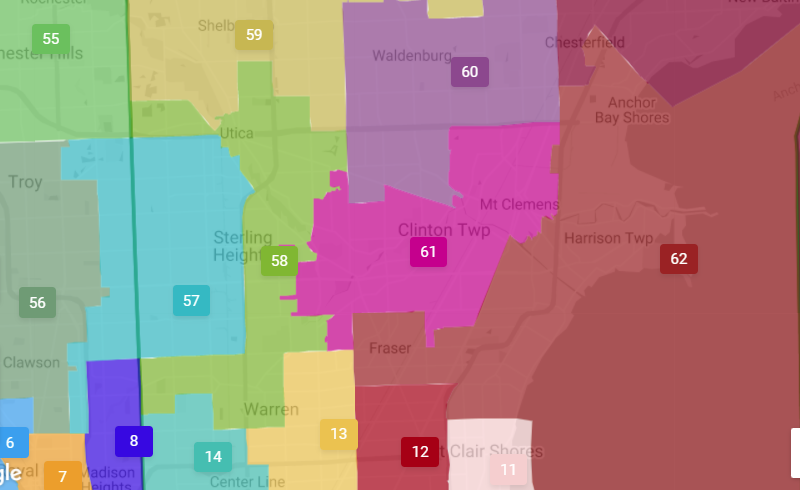The new Michigan legislative districts approved on Tuesday could overhaul Macomb County politics as they dramatically redraw the election maps starting next year and mark the first time that some district boundaries in Macomb will extend south of Eight Mile Road into Detroit.
In addition, the congressional lines redrawn by the state’s redistricting commission have already upended the 2022 election outlook in Macomb, with Congressman Andy Levin deciding to run for re-election in an Oakland County district rather than in the district he currently represents, which was altered to entail mostly territory in Macomb County – and not his residence in Bloomfield Township.
That creates a wide open 2022 race for Congress in the revised district, which includes all of Macomb south of Hall Road, plus Rochester and Rochester Hills, Shelby Township and a bit of Macomb Township.
Far more ground-shaking is the creation of several state House and Senate districts that will extend from south Macomb deep into Detroit, including some of the inner city’s most battered east side neighborhoods. This new geometric dynamic likely will generate highly competitive races between black Detroit candidates and white Macomb contenders.
For example:
- The newly drawn 11th House District encompasses all of St. Clair Shores and moves south into Harper Woods and Detroit, following the Grosse Pointes’ border down nearly to East Outer Drive. This district’s voting population is a 49-49 percent deadlock between white and black voters.
- The adjacent 12th House District includes Roseville and Eastpointe and dips south, bordered by Gratiot Avenue and Kelly Road, down nearly to Outer Drive. This district is 51 percent white, 47 percent black.
- The new 13th House District extends from Warren’s northeast border, 14 Mile Road and Hayes, south to the area of Detroit City Airport and Chandler Park at I-94. That district is 51 percent white and 43 percent black.
- The 14th House District includes a majority of Warren, stretching from 13 Mile Road through the enclave of Center Line, and south into Detroit along Conant Street until just short of Hamtramck. The demographics indicate the 14th is 47 percent black, 43 percent white.
Twenty years ago, Macomb’s House and Senate districts were contained entirely within the county’s boundaries. For the past 10 years, a few districts strayed nominally into portions of St. Clair County.
But the fresh approach taken by the Michigan Independent Redistricting Commission, a bipartisan body approved by Michigan voters in 2018 to end gerrymandering, places a heavy emphasis on “communities of interest” – aligning communities with common interests within a single district.
So, the new maps in Macomb establish legislative boundaries in ways that will result in most lawmakers representing diverse districts that include portions of neighboring counties.
South Macomb areas that have become far more diverse in population, particularly with a substantial increase in black voters, are linked with adjacent Detroit neighborhoods to create districts that present competitive battlegrounds, at least in Democratic primaries, between blacks and whites.
Waterfront communities – communities of like-minded interests – have been mapped out along Lake St. Clair to provide a district, one in the House, one in the Senate, that extend along the waterfront. In the Senate version, it’s all the way from New Baltimore to the Grosse Pointes.
Along the Dequindre Road corridor, two Senate districts encompass the large Chaldean and Asian community in Warren and Sterling Heights. District 10, with an 18 percent Asian constituency, incorporates western Sterling Heights, Troy, Rochester and Rochester Hills.
The adjacent District 3, nearly equally divided between blacks and whites, but with more than 11 percent Asian, centers on western Warren. The district then flows south into Detroit, through Hamtramck, with its large Muslim population, and then all the way to downtown Detroit.
Establishing wholly rural districts also emerged as a priority of the redistricting commission. The new 25th Senate District comprises northwest Macomb County (New Haven, Armada and Richmond) but also reaches northward through several counties to the tip of the Thumb Area.
The 24th Senate District entails much of the rest of northern Macomb (Romeo, Washington Township, Shelby Township) but then shifts west through numerous rural communities in Oakland and Lapeer counties and just short of Grand Blanc in Genesee County.
The result of all this chaotic cartography will be open seats that attract a crowd of candidates, and districts with two incumbents lumped together, fighting for campaign survival, and who may beat each other into submission, providing an opening for a newcomer. Some lawmakers surveying the new election battleground may simply call it quits. We have all of this, plus the impact of term limits for some representatives and senators who are on their way out.
It all adds up to a lot of new faces on 2022 ballots across Macomb County.
To view the maps, use the links below. You will need to zoom in substantially to get a good look at the Macomb County districts.




